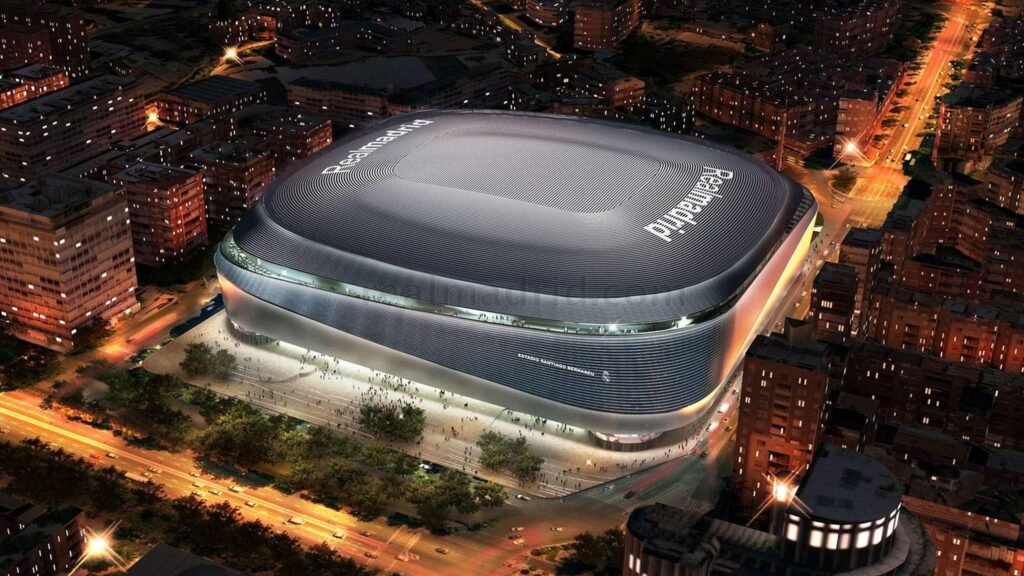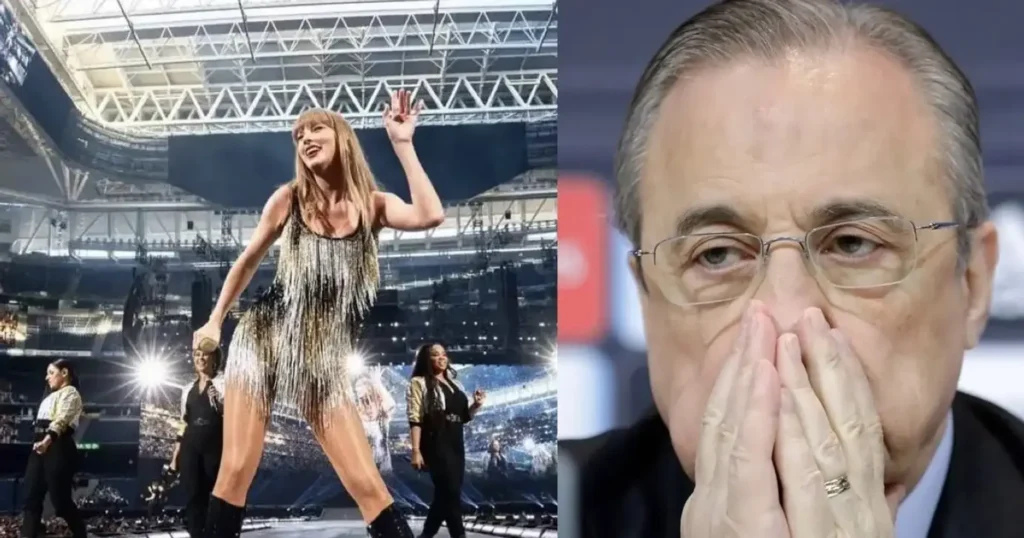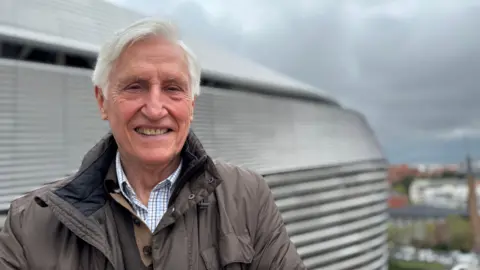The Impact of Real Madrid Stadium Noise on Local Residents
In recent years, Real Madrid stadium noise has become a growing point of contention in Madrid’s upscale Chamartín district. The iconic Santiago Bernabéu Stadium—home to football giants Real Madrid—was transformed into a state-of-the-art, multi-purpose venue after a €1.1 billion renovation completed in 2024. Designed to attract global music stars like Taylor Swift, Ed Sheeran, and AC/DC, the revamped stadium promised new streams of revenue through live events. However, what began as a vision of progress has quickly erupted into a legal battle, as residents allege that unbearable noise levels from frequent concerts are disrupting their lives and health.
Residents’ Legal Fight Against Real Madrid Stadium Noise

The issue of Real Madrid stadium noise gained international attention when tens of thousands of Taylor Swift fans, known as ‘Swifties,’ filled the Bernabéu stadium in late May 2024 for two electrifying performances. These shows, which took place less than a day before Real Madrid’s victorious UEFA Champions League final, were meant to mark a milestone in the club’s modernisation efforts. However, the roaring success on the field was quickly overshadowed by growing concerns about the Real Madrid stadium noise that residents described as unbearable.
By September 2024, mounting legal pressure forced the club to cancel all upcoming concerts at the venue. Residents living within earshot of the Bernabéu had filed a formal complaint, citing excessive Real Madrid stadium noise as a serious threat to public health and wellbeing. Many of these complainants are lifelong Real Madrid supporters who never expected their beloved stadium to become the source of such relentless disruption.
The Impact of Real Madrid Stadium Noise on the Local Community
Enrique Martínez de Azagra, president of the local neighbourhood association, is leading the resistance. “Every concert is the same—unbearable noise, continuous vibrations, and no peace for hours,” he says. As an engineer, Enrique understands the gravity of the issue, asserting that continuous exposure to over 90 decibels is far beyond tolerable and legally acceptable levels.
According to data collected by residents, noise levels during concerts often peaked above 90 decibels. The European Environment Agency, represented by Ian Marnane, considers sustained exposure to noise above 55 decibels hazardous, with links to high blood pressure, cardiovascular diseases, strokes, and even diabetes.
“This isn’t just an annoyance. It’s a serious health concern,” Enrique emphasizes, citing cases of insomnia, migraines, and even panic attacks experienced by residents during concert nights.
How Real Madrid Stadium Noise Affects Residents Differently
For Enrique and his neighbours, there’s a clear difference between the noise produced during a football match and that of a full-blown music concert. “Football matches are temporary and passion-driven—cheers, boos, and bursts of joy when there’s a goal. But concerts are hours-long events with unrelenting noise that rattles windows and minds alike,” he says.
Indeed, the residents have coexisted with the roar of football fans for decades without complaints. But the transformation of the stadium into a concert venue, hosting 20 or more events annually, has changed the equation.
The Legal Front: Residents vs. Real Madrid
The neighbourhood association has now taken the issue to court, accusing the club of violating national noise regulations and endangering public health. Sports journalist Filippo Maria Ricci believes the residents have a compelling case. “This isn’t just any neighbourhood. These are well-connected, influential residents who know the legal landscape. Real Madrid may have underestimated their ability to organize,” he notes.

Despite the court case still ongoing, its effects are already visible. Spanish pop star Aitana, scheduled to perform at the Bernabéu, has moved her event to Atlético Madrid’s Metropolitano Stadium instead. Other international acts such as Imagine Dragons and AC/DC have followed suit, effectively handing Real Madrid’s rivals a cultural advantage.
A Multibillion-Euro Investment in Question
Real Madrid’s grand vision for a multi-functional Bernabéu included a new retractable roof and a removable pitch, designed to transform the stadium from football field to concert hall in hours. A major contract with a U.S. company to commercialize the venue was signed with high expectations. Yet, all that innovation may have been for nothing.
“Now all this new super system is quite useless,” says Filippo. “All that money is gone, at least temporarily, as concerts move to rival stadiums.”
The silence at the Bernabéu has financial implications far beyond ticket sales. Local media reports indicate that Taylor Swift’s concerts alone contributed around €25 million to Madrid’s economy. The loss of future events not only affects the club’s revenue but also hits local businesses, hotels, and restaurants.
Government’s Complicated Position
The city government appears caught in a bind. On the one hand, it benefits significantly from the influx of tourism and spending associated with concerts. On the other hand, the legal and social pressure from voters and residents is increasing.
Residents accuse the city council of dragging its feet. “It feels like the government is deliberately stalling,” says lawyer and resident Pablo Baschwitz. “They are profiting from the chaos.”
The Futility of Soundproofing Efforts
In an attempt to reconcile, Real Madrid has hired experts to explore soundproofing options. New windows have been installed in parts of the stadium, and modifications have been made to the roof. But these measures have largely failed to win community trust.

Enrique scoffs at the idea. “The structure isn’t designed to contain noise,” he says. “There’s a visible gap between the retractable roof and the façade—how can you seal that?”
The Impact Beyond Concert Nights
It’s not just the concerts themselves that cause disruption. Residents complain of extended sound checks, rehearsals, and lighting tests that occur throughout the day. Schools and health centres in the vicinity struggle to function during these noisy periods.
Luis Jordana de Pozas, who lives across the street, points to how metal plates added during the renovation have worsened the acoustics. On his balcony, he plays back videos where vibrations and sound distortions are clearly visible. He’s also helped record decibel readings both inside and outside his apartment as evidence for the court.
Cultural Divide: A City Torn Between Music and Sport
From balconies and terraces across the district, protest banners hang like battle flags. Slogans such as “Conciertos No” (No Concerts) and “Ruido No” (No Noise) are prominently displayed.
Despite the outcry, residents insist they aren’t against music events entirely. “We’ve had great performances before—Frank Sinatra, Julio Iglesias. Once a year was fine. But 20 concerts a year is excessive,” says Pablo.
Alternative Venues and A Shifting Landscape
While the Bernabéu battles controversy, Atlético Madrid’s Metropolitano Stadium has stepped into the spotlight as a more suitable venue. Located away from dense residential areas, the stadium has become the go-to site for major concerts in the city.
“It’s ironic that Real Madrid invested billions to outshine rivals, but ended up handing them cultural victories,” says Filippo.
What Lies Ahead: The Verdict Awaits
As the legal battle stretches on, both Real Madrid and the local community face an uncertain future. Will the court side with health and residential rights, or will the economic benefits of mega-events prevail?
For now, the music at Bernabéu has stopped—but the echoes of discontent continue to ring across the city.
Conclusion: A Lesson in Urban Planning and Balance
The dispute between Real Madrid and its neighbours reveals a broader challenge in urban development—how to modernize and maximize revenue without compromising the quality of life for residents. The Bernabéu’s transformation was intended as a symbol of Madrid’s cultural and commercial prowess. Instead, it has become a case study in the unintended consequences of mixing sport, entertainment, and community in tightly packed urban environments.
As the city watches and waits for the court’s final decision, one thing remains clear: the battle over noise at the Bernabéu is about more than decibels—it’s about identity, tradition, and the future of shared space in the modern metropolis.




